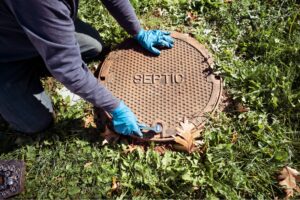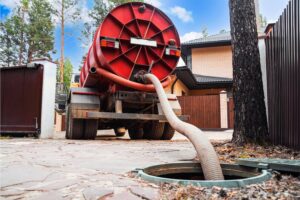by Paige Jessup, Climate Change Resiliency Intern
Proper design and maintenance of your septic system is important in ensuring it functions properly and will not end up costing you and the environment. Improperly treated wastewater may contain bacteria, viruses, phosphorus, and nitrogen. If this gets into the ground water or nearby water body, it can get into drinking water and also have devastating consequences for aquatic ecosystems.
Choosing and Designing your Septic System
There are several factors that should be considered when designing your septic system, the first being size. You should know your home’s daily wastewater release. To do this, you must factor the number of occupants, number of bedrooms, and the home’s size. The next step will be choosing the type of system that suits you and your family’s needs. One of the most common and affordable septic types available is a conventional system. This type of system is placed in the ground in a large, often circular container and is usually made of plastic or metal. It is used in conjunction with a drain field.
There are many other types of systems available. There is the drip distribution system that requires a large amount of piping and has much less disruption of the lawn to install. Next is an aerobic treatment unit which is very efficient at managing waste and can be one of the best options available, although they tend to be more expensive to install. Mound systems are best for individuals who need an economical unit that is does not require a lot of space. A recirculating sand filter system has two septic tank areas and a built-in sand-based filter system that can last for years. This type of system does have more physical parts to install.
There are also evapotranspiration systems which are an excellent choice for the environment and will help you keep a clean and efficient septic system. A constructed wetland system is a good option for a home built on a wetland area. This system type is designed to work with the nearby water system to filter your wastewater so it is safe to be reused. Finally, you may consider a cluster/community system if you are looking for a more cost-efficient option for a large suburban area (not a single home).

Once you know what kind of a septic system you want to install and you install it, there are some best practices for maintenance:
Do’s
- Know where your tank and drain field are.
- Reduce your household water use.
- Have your system inspected and pumped regularly.
- Pump out your septic tank in summer and early fall to ensures the tank will have time to refill and re-establish bacterial activity before winter.
- Keep your septic system accessible so it can be properly maintained.
- Keep a perimeter around the edge of the drain field that is clear of trees and shrubs.
Don’ts
- Don’t drive or park vehicles on top of your drain field. This can compact the soil and damage pipes.
- Don’t use cleaners, soaps, and detergents with phosphates.
- Don’t use septic additives. They are not necessary or effective and some may harm your system.
- Don’t flush anything that you didn’t produce, except for toilet paper! That means no fats, grease, paints, cat litter, sanitary products, diapers, wipes, cigarette butts, or kitchen waste.
- Don’t water your lawn over the drain field.
All of these things will keep your system from being damaged and leaving you with a costly bill to replace or fix it. Keeping these best practices will also help prevent accidental pollution of surrounding water bodies.
Inspecting and Pumping
It is important to get your septic tank inspected at least every three years and have it pumped out every three to five by a professional. An inspector will look for leaks, blockages, soil absorption issues, mechanical failures, and any signs of wear and tear in your septic system components. You want to be diligent about pumping out your septic tank in case a large amount of water enters the septic tank or the tank fills up with solids. If this happens, the system can push the solids into the drain field, resulting in clogged pipes and thickening biomats. When the untreated wastewater is pushed back up to the drain field, it could cause it to run off into nearby water bodies.

Preventative Maintenance
There are a few thing you can do in your day-to-day life to keep your septic system running smoothly. First, make sure to use water efficiently as much as possible. The more water a household conserves, the less water enters the septic system. Second, be sure to properly dispose of waste, and only flush human waste and toilet paper. Make sure to consider the ongoing maintenance of your drain field so it can do its job in removing contaminants from the liquid that emerges from your septic tank. Finally, if you are on a septic system, it is likely your neighbours also have one. Share information about the harmful effects of wastewater pollution with neighbours and encourage them to adopt best practices.
This blog is part of a larger education toolkit about septic systems. To access all of the resources from the toolkit, visit watersheds.ca/septics
Your $5 donation today will ensure more landowners, municipalities, and families have access to the resources they need to protect Canada’s freshwater – donate now!
References
“10 Different Types Of Septic Systems + How to Choose the Right One.” (n.a.). The Original Plumber Septic. Retrieved from https://theoriginalplumber.com/plumbing-tips/types-of-septic-systems/
“How to Care for Your Septic System.” (2024). United States Environmental Protection Agency. Retrieved from https://www.epa.gov/septic/how-care-your-septic-system
